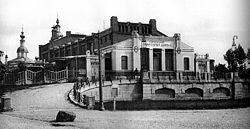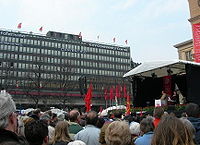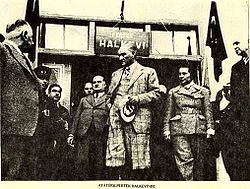
People's Houses
Encyclopedia
People's Houses were originally leisure and cultural centres built with the intention of making art and cultural appreciation available to the working classes. They flourished from the late-nineteenth century, first appearing in the British Isles in grim and less salubrious urban areas - particularly in the north of England and in Scotland - then spread through Continental Europe reaching eastwards to Russia and Turkey.
Notably these were built according to neo-Gothic style, as promoted by Augustus Pugin
and John Ruskin
: Pugin believed the harmonious style of the architecture could influence morality, while Ruskin in his book The Stones of Venice
examined the architecture of the Italian Renaissance mercantile republics, believing it expressed the spirit of freedom. Architects adopted these ideas in their building of People's Palaces in the north of England and in Scotland, both to assert the cultural credentials of those regions and to provide an improving influence over the citizens of burgeoning industrial towns.
 Temperance Committees had been established throughout Russia in the late nineteenth century, their officials appointed by the government and charged with promoting abstinence from alcohol but with the recognition that other more healthy forms of pleasure should be provided. Building People's Houses, following the example set by Britain, was considered a possible solution.
Temperance Committees had been established throughout Russia in the late nineteenth century, their officials appointed by the government and charged with promoting abstinence from alcohol but with the recognition that other more healthy forms of pleasure should be provided. Building People's Houses, following the example set by Britain, was considered a possible solution.
The first such Houses were erected in St. Petersburg in 1880, and by the beginning of the twentieth century the city supported about 20: these provided entertainment, educational clubs for middle-class intelligentsia, petty officials, students, soldiers and workers. The biggest and most famous People's House to be opened in Russia was built in Alexandrovsky Park
in 1899-1900, and opened by Tsar Nicholas II, after whom it was named "Narodny Dom Imperatora Nikolaya II". This originally housed a concert hall, a theater, a public library and a restaurant. There was a small nominal entrance charge, with the only extra being charged for a seat at the theater. The English publication Contemporary Review noted these facilities, enviously commenting:"it is exactly what our People's palace was intended to be and is not".
More such People's Houses were built in St. Petersburg, Moscow and other places in Russia. As a rule, they were usually built in the working-class neighbourhoods. Typically People's House featured a theatre and a lecture hall, a library with reading and tea-rooms. Often Sunday schools for children and grown-ups were organised. People's houses were subsidized by the Municipal Dumas, country councils and donations of private individuals.
After the 1917 revolution term "people's house" fell out of use. Most people's houses were renamed into the worker's clubs or Houses of Culture
.
 In Sweden "The People's House" is the name of proletarian community centre
In Sweden "The People's House" is the name of proletarian community centre
s located in almost all cities.
When the Swedish labour movement
and trade union
s began to organize towards the end of the 19th century, the workers were in great need for premises of their own where they could hold meetings without interference. Opposition against the labour movement from the capitalists
and landlord
s was strong and workers were not welcome to use existing premises. Landowners even forbade open-air meetings.
The workers in Sweden decided to buy their own land and build their own houses. The idea spread all over the country. Construction was funded through co-operative ventures, various forms of contribution and not least voluntary work.
"The people's park" (folkets park) is also a prevalent feature of many Swedish towns, serving similar purposes.
started in 1897 and the house was opened in 1901, located at Norra Bantorget
.
In 1906 the Russia
n Bolshevik
s and Menshevik
s were welcomed to hold their fourth congress at Stockholm Folkets hus.
In 1955 the original Stockholm people's house was demolished, as most of lower Norrmalm during the 1950s, 1960s, and 1970s. It was replaced by the current people's house building, which was built at the same place.
 In Turkey people's houses were established in 1932, to give formal education to adults (Adult education
In Turkey people's houses were established in 1932, to give formal education to adults (Adult education
). The People's House developed programs on language and literature, fine arts, library and publications, history and museum, drama, sports, social assistance, educational classes, and village development.
On July 2, 1932 the first Turkish History Conference was assembled in the Ankara People's House.
The activities of the people's houses were subsidized from the state treasury. It served all the people. Yaşar Kemal
's early poems to be published besides his folklore studies in the journal of the "Adana People's House".
In 1945-1951, with the establishment of multi-party politics in Turkey, most of the initial initiatives supported by the Republican People's Party
(RPP) began to be questioned. The opposition Democratic Party wanted to put an end to the People's Houses. DP perceived the People's Houses as a strong political institution among the civilians which propagates the RPP's point of view. First, DP wanted to cut the public expense from the government budged to the institution. RPP proposed to reorganize them instead of closing. RPP wanted to preserve the institution as an Atatürk's heritage. The DP, who criticized the houses for closely identifying with the RPP, rejected the proposal. The property of people's houses confiscated, after the DP had the majority in the Turkish Grand National Assembly in 1951.
In United Kingdom
In the late nineteenth century People's Palaces started being built in grim urban districts. The concept was to raise morale and morality through inspiring buildings which offered cultural nourishment. Costly, taking years to build and lavishly decorated they were designed to provide a focal point for civic pride, venues for meetings and public events.Notably these were built according to neo-Gothic style, as promoted by Augustus Pugin
Augustus Pugin
Augustus Welby Northmore Pugin was an English architect, designer, and theorist of design, now best remembered for his work in the Gothic Revival style, particularly churches and the Palace of Westminster. Pugin was the father of E. W...
and John Ruskin
John Ruskin
John Ruskin was the leading English art critic of the Victorian era, also an art patron, draughtsman, watercolourist, a prominent social thinker and philanthropist. He wrote on subjects ranging from geology to architecture, myth to ornithology, literature to education, and botany to political...
: Pugin believed the harmonious style of the architecture could influence morality, while Ruskin in his book The Stones of Venice
The Stones of Venice (book)
The Stones of Venice is a three-volume treatise on Venetian art and architecture by English art historian John Ruskin, first published from 1851 to 1853. Intending to prove how the architecture in Venice exemplified the principles he discussed in his earlier work, The Seven Lamps of Architecture,...
examined the architecture of the Italian Renaissance mercantile republics, believing it expressed the spirit of freedom. Architects adopted these ideas in their building of People's Palaces in the north of England and in Scotland, both to assert the cultural credentials of those regions and to provide an improving influence over the citizens of burgeoning industrial towns.
In Russia

The first such Houses were erected in St. Petersburg in 1880, and by the beginning of the twentieth century the city supported about 20: these provided entertainment, educational clubs for middle-class intelligentsia, petty officials, students, soldiers and workers. The biggest and most famous People's House to be opened in Russia was built in Alexandrovsky Park
Alexander Garden (Saint Petersburg)
The Alexander Garden lies along the south and west façades of the Russian Admiralty in St. Petersburg, parallel to the Neva River and Admiralty Quay, extending from Palace Square in the east to St. Isaac's Cathedral in the west. The English park is named after Alexander II of Russia who ordered...
in 1899-1900, and opened by Tsar Nicholas II, after whom it was named "Narodny Dom Imperatora Nikolaya II". This originally housed a concert hall, a theater, a public library and a restaurant. There was a small nominal entrance charge, with the only extra being charged for a seat at the theater. The English publication Contemporary Review noted these facilities, enviously commenting:"it is exactly what our People's palace was intended to be and is not".
More such People's Houses were built in St. Petersburg, Moscow and other places in Russia. As a rule, they were usually built in the working-class neighbourhoods. Typically People's House featured a theatre and a lecture hall, a library with reading and tea-rooms. Often Sunday schools for children and grown-ups were organised. People's houses were subsidized by the Municipal Dumas, country councils and donations of private individuals.
After the 1917 revolution term "people's house" fell out of use. Most people's houses were renamed into the worker's clubs or Houses of Culture
Palace of Culture
Palace of Culture or House of Culture was the name for major club-houses in the former Soviet Union and the rest of the Eastern bloc. It was an establishment for all kinds of recreational activities and hobbies: sports, collecting, arts, etc., and the Palace of Culture was designed to have room...
.
In Sweden

Community centre
Community centres or community centers or jumping recreation centers are public locations where members of a community tend to gather for group activities, social support, public information, and other purposes. They may sometimes be open for the whole community or for a specialised group within...
s located in almost all cities.
When the Swedish labour movement
Swedish labour movement
The labour movement in Sweden dates back to at least the 1850's, when Swedish workers initiated the organizing of previously spontaneous food riots into strikes, hence acting as an autonomous group. Modern types av labour unions emerged in the 1870's...
and trade union
Trade union
A trade union, trades union or labor union is an organization of workers that have banded together to achieve common goals such as better working conditions. The trade union, through its leadership, bargains with the employer on behalf of union members and negotiates labour contracts with...
s began to organize towards the end of the 19th century, the workers were in great need for premises of their own where they could hold meetings without interference. Opposition against the labour movement from the capitalists
Capitalism
Capitalism is an economic system that became dominant in the Western world following the demise of feudalism. There is no consensus on the precise definition nor on how the term should be used as a historical category...
and landlord
Landlord
A landlord is the owner of a house, apartment, condominium, or real estate which is rented or leased to an individual or business, who is called a tenant . When a juristic person is in this position, the term landlord is used. Other terms include lessor and owner...
s was strong and workers were not welcome to use existing premises. Landowners even forbade open-air meetings.
The workers in Sweden decided to buy their own land and build their own houses. The idea spread all over the country. Construction was funded through co-operative ventures, various forms of contribution and not least voluntary work.
"The people's park" (folkets park) is also a prevalent feature of many Swedish towns, serving similar purposes.
Stockholm
The construction of first people's house in StockholmStockholm
Stockholm is the capital and the largest city of Sweden and constitutes the most populated urban area in Scandinavia. Stockholm is the most populous city in Sweden, with a population of 851,155 in the municipality , 1.37 million in the urban area , and around 2.1 million in the metropolitan area...
started in 1897 and the house was opened in 1901, located at Norra Bantorget
Norra Bantorget
Norra Bantorget is an area in central Stockholm. It is the traditional Social Democratic grounds of the Swedish capital...
.
In 1906 the Russia
Russia
Russia or , officially known as both Russia and the Russian Federation , is a country in northern Eurasia. It is a federal semi-presidential republic, comprising 83 federal subjects...
n Bolshevik
Bolshevik
The Bolsheviks, originally also Bolshevists , derived from bol'shinstvo, "majority") were a faction of the Marxist Russian Social Democratic Labour Party which split apart from the Menshevik faction at the Second Party Congress in 1903....
s and Menshevik
Menshevik
The Mensheviks were a faction of the Russian revolutionary movement that emerged in 1904 after a dispute between Vladimir Lenin and Julius Martov, both members of the Russian Social-Democratic Labour Party. The dispute originated at the Second Congress of that party, ostensibly over minor issues...
s were welcomed to hold their fourth congress at Stockholm Folkets hus.
In 1955 the original Stockholm people's house was demolished, as most of lower Norrmalm during the 1950s, 1960s, and 1970s. It was replaced by the current people's house building, which was built at the same place.
In Turkey

Adult education
Adult education is the practice of teaching and educating adults. Adult education takes place in the workplace, through 'extension' school or 'school of continuing education' . Other learning places include folk high schools, community colleges, and lifelong learning centers...
). The People's House developed programs on language and literature, fine arts, library and publications, history and museum, drama, sports, social assistance, educational classes, and village development.
On July 2, 1932 the first Turkish History Conference was assembled in the Ankara People's House.
The activities of the people's houses were subsidized from the state treasury. It served all the people. Yaşar Kemal
Yasar Kemal
Yaşar Kemal, is a Turkish writer. He is one of Turkey's leading writers. He has long been a candidate for the Nobel Prize in Literature, on the strength of Memed, My Hawk....
's early poems to be published besides his folklore studies in the journal of the "Adana People's House".
In 1945-1951, with the establishment of multi-party politics in Turkey, most of the initial initiatives supported by the Republican People's Party
Republican People's Party (Turkey)
The Republican People's Party is a centre-left Kemalist political party in Turkey. It is the oldest political party of Turkey and is currently Main Opposition in the Grand National Assembly. The Republican People's Party describes itself as "a modern social-democratic party, which is faithful to...
(RPP) began to be questioned. The opposition Democratic Party wanted to put an end to the People's Houses. DP perceived the People's Houses as a strong political institution among the civilians which propagates the RPP's point of view. First, DP wanted to cut the public expense from the government budged to the institution. RPP proposed to reorganize them instead of closing. RPP wanted to preserve the institution as an Atatürk's heritage. The DP, who criticized the houses for closely identifying with the RPP, rejected the proposal. The property of people's houses confiscated, after the DP had the majority in the Turkish Grand National Assembly in 1951.

